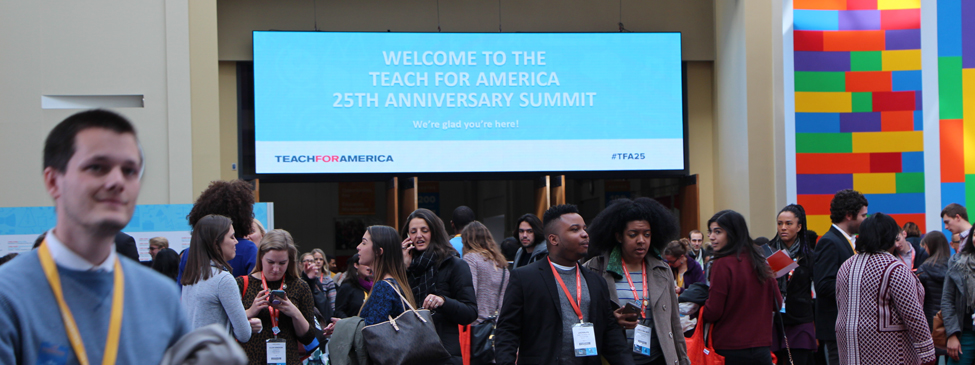I have Teach For America to thank for bringing me to education. I was a charter corps member, teaching middle school science in New Orleans, so I’m about as old-school-TFA as you can get. Lately, I’ve been thinking a lot about the organization’s contributions to the field. Following TFA’s 25th anniversary summit, I’ve been considering how far the education reform movement has come—and all the work that still remains.
In the early days, we used to respond to critics by saying we hoped there was a day when TFA was no longer needed. We viewed our work as a temporary solution to an emergency problem: chronic teacher shortages in high-poverty schools. I don’t think it occurred to any of us that TFA would get to 25.
Rather than put ourselves out of business, of course, TFA and likeminded organizations like TNTP have only grown. TFA shifted away from the goal of solving an emergency problem and toward cultivating leaders who will be in the work for the long haul—in classrooms, schools, and school systems. I’m particularly proud that TFA alumni have played a big role in creating a robust charter sector, founding charter networks that have repeatedly demonstrated that students from under-resourced communities can achieve at high levels. Today, everywhere you look in education—in schools and districts and state departments—TFA alumni are making their marks.
Those are great successes. But as the reform movement has grown, a huge question has emerged: How do we scale solutions sustainably? How do we go from propelling pockets of students to success to entire cities’ and states’ worth? In confronting this issue head-on, I wonder if TFA may have made one of its greatest contributions to the movement: helping us recognize the importance of true partnerships with local communities—and shifting our approach to the work as a result.
Back in 1990, TFA marketed itself as recruiting the best and brightest from elite colleges across the country. It cultivated an aura of selectivity, and we were perceived (rightly, most of the time) as outsiders. I remember being humbled by how much I needed to learn, not only to teach well but also to connect with families and appreciate Uptown, the New Orleans neighborhood I was teaching in. Today, we understand that those community roots are an essential part of the work, rather than an afterthought—and that’s a mindset shift that has had important implications for how we recruit and train teachers, and for how we define success.
Increasingly, the new leaders TFA is introducing to the field bring with them deeply personal knowledge of the challenges facing low-income students and students of color. Just over 50 percent of the 2015 corps are teachers of color. Thirty-four percent are the first in their own families to attend college; 47 percent received Pell Grants. Over the years, we’ve seen the former students of TFA-trained teachers grow up, go to college, and return as corps members in their own hometowns. At TNTP, we’ve invested in similar efforts, training school leaders from communities we serve, like Camden, New Jersey, through our PLUS programs. We are also proud of the growing diversity of the Teaching Fellows we recruit and train, more than 40 percent of whom are people of color. We are also investing much more deeply in community engagement work, helping school systems engage their communities authentically and respectfully.
Alongside these efforts are questions of how to meet the needs of local communities. From its inception, TFA has grappled with ensuring consistency in its program nationally while adjusting to the needs of a particular region—a challenge we share at TNTP. When we are a national organization, how do we balance organizational sustainability—pushing to expand our work in a particular place—with supporting local communities as they develop their own solutions? Over time, we’ve learned that we can’t expect a blueprint that works in one community to necessarily work in another, and real, sustained change must be done in partnership with communities. Today, in places like Missouri and Louisiana, TFA staff and corps members have become critical voices to support larger community-based movements to combat poverty and challenge institutional racism—as well as to improve public education.
Preparing teachers to grapple with the broader challenges facing their local communities is work that is just as relevant today as it was 25 years ago. But I think (and hope) we are smarter about it now than we were then. I was a corps member in 1992 when four police officers were acquitted of using excessive force after they were caught on video beating Rodney King. It’s hard to watch the news these days in Baltimore or Ferguson and feel that we have made much progress as a nation. For us in education, a huge part of the work ahead must focus on elevating solutions that come from within communities. We’re far from finished. But I’m not sure we would even be having the conversation without TFA and the incredibly diverse group of leaders it has brought to the fight for education equity and social justice.








